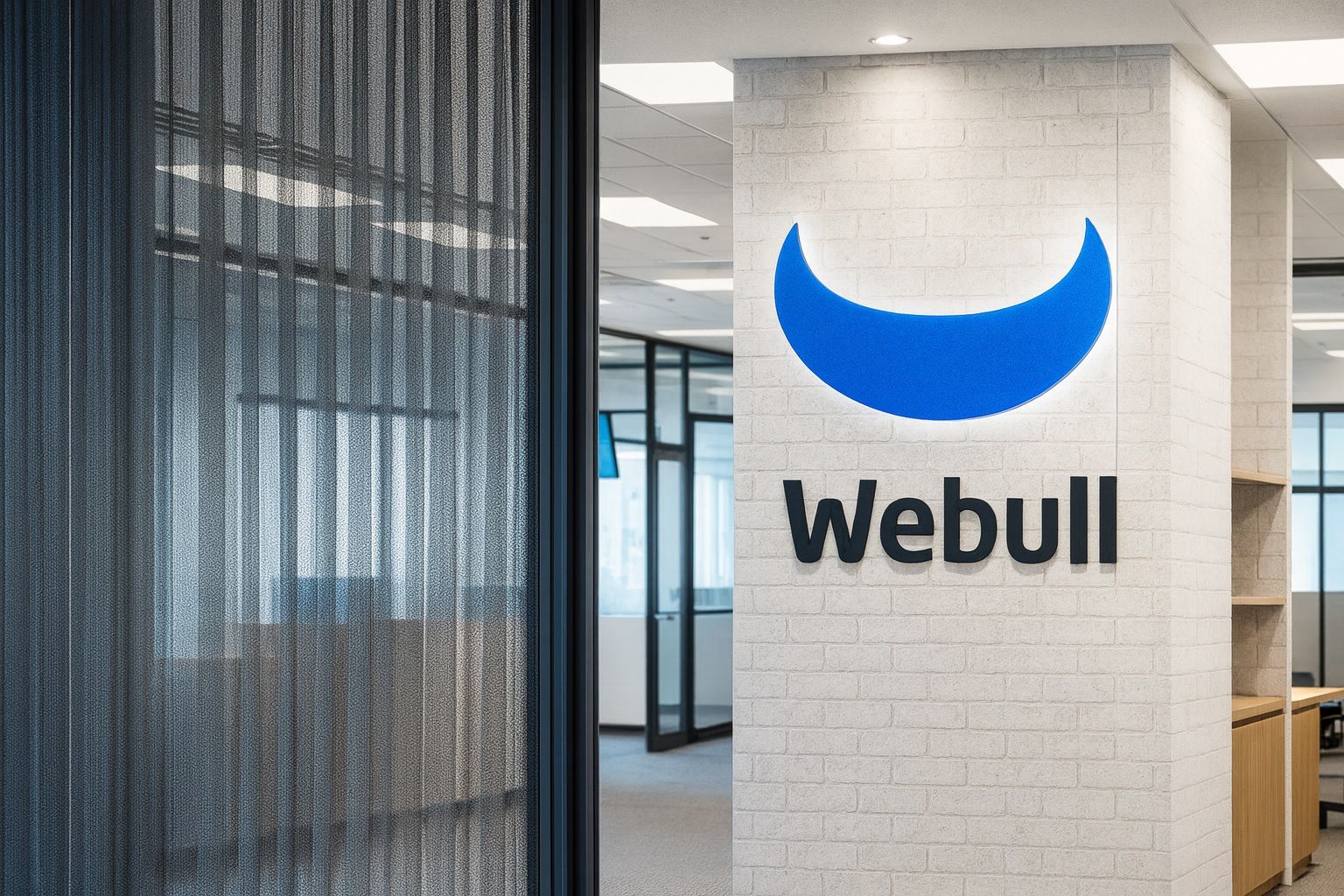- Trading App Powerhouse:Webull Corporation (NASDAQ: BULL) operates a global commission-free trading platform (stocks, ETFs, options, crypto) with over 24 million users across 14 countries [1]. Founded in 2016 by former Alibaba executive Wang Anquan, Webull went public via a SPAC merger in April 2025 [2], debuting on Nasdaq under ticker “BULL.”
- Rollercoaster IPO and Crash:BULL stock skyrocketed ~500% in its first days – hitting an intraday high around $79.56 – before plunging over 85% from that peak [3]. As of Oct 8, 2025, shares trade around $12 (near all-time lows around $9.54 [4]), meaning the stock has round-tripped back near its SPAC IPO price after an explosive start. It remains up ~5–10% year-to-date despite the wild swings [5].
- Growth is Booming (Yet Unprofitable): Webull’s revenue is surging – Q2 2025 sales jumped +46% YoY to $131.5 M [6] on record customer assets (~$15.9 B, +64% YoY) and rising trading volumes [7]. The company has delivered three straight quarters of positive operating profit, but still posts net losses due to one-time SPAC costs and stock-based expenses [8]. Analysts note Webull’s GAAP EPS is improving (–$0.06 in Q1 vs –$7.98 a year prior) but “still a loss” overall [9] [10].
- Lock-Up Expiry Triggers Sell-Off: A massive shareholder lock-up expiration in early October 2025 freed ~455.6 million insider shares [11]. Ahead of this, BULL plunged 6.6% on Oct 7 as investors braced for insider selling, then fell another ~6% on Oct 8 after a 3 million-share block trade at $12.50 signaled at least one big holder offloading stock [12] [13]. These back-to-back drops – the worst since August – fueled fears of more insider dumping in the near term.
- Analysts See Upside: Despite volatility, Wall Street remains bullish on BULL. Rosenblatt Securities initiated coverage in late September with a Buy rating and $19 price target, arguing Webull is undervalued vs. Robinhood and can sustain over 25% annual revenue growth through 2027 [14] [15]. Similarly, Northland Capital started at Outperform with an ~$18 target [16] [17]. The consensus 12-month target is ~$18.50 (implying ~50–60% upside from current levels) and analyst sentiment is “Strong Buy.” [18]
Company Overview
Webull is a digital brokerage platform that offers commission-free trading of stocks, ETFs, options, and cryptocurrencies via a sleek mobile app and web interface [19]. Often likened to Robinhood, Webull monetizes primarily through payment for order flow and premium add-on services (like subscriptions for advanced data) [20] [21]. The platform launched in the U.S. in 2018 and quickly gained traction among tech-savvy retail investors thanks to its zero-commission model and feature-rich tools. Webull has since expanded globally – by mid-2025 it was operating in 14 countries across North America, Europe, Asia, Africa and more via local licensed broker-dealer entities [22] [23].
Originally founded in China (with early backing from Xiaomi and others), Webull re-domiciled to the U.S. and established headquarters in New York (later St. Petersburg, Florida) to alleviate U.S.–China regulatory concerns [24] [25]. These moves paved the way for Webull’s public listing: in April 2025, it merged with SK Growth Opportunities, a SPAC affiliated with South Korea’s SK Group, bringing Webull to Nasdaq under the ticker “BULL” [26]. Webull’s Class A shares began trading on April 11, 2025 [27].
Scale & Products: Today, Webull positions itself as a global alternative to traditional brokerages and other trading apps. It boasts roughly 25 million registered users (~4.7 million funded accounts) and about $15–16 billion in customer assets as of mid-2025 [28]. This still trails far behind industry leader Robinhood (which has ~25 M funded accounts and ~$193 B in assets under custody) [29] [30], but Webull has been expanding internationally at a much faster pace. In fact, Webull is already licensed in more countries than Robinhood – including the UK, EU nations, Australia, Japan, Singapore, South Africa and more [31]. Management hopes this broader geographic footprint will drive long-term growth, tapping markets beyond the U.S. For example, in September 2025 Webull officially launched in Europe by rolling out services in the Netherlands, its first EU market [32].
On the product side, Webull offers 24/7 crypto trading, equities and options trading during extended hours, IRAs, and even a social community feature. Notably, Webull re-entered the cryptocurrency business in mid-2025 – it had temporarily spun off its crypto unit in 2023 due to regulatory uncertainty, but as the U.S. climate improved, Webull relaunched crypto trading for U.S. users in August 2025 [33]. It integrated crypto wallets (“Webull Pay”) and began offering crypto trading in more international markets like Brazil [34]. This is a strategic move: at the peak of the last crypto cycle, crypto trading accounted for roughly 20% of Webull’s revenues, so regaining a foothold in digital assets could boost engagement and revenue if crypto markets stay active [35]. As Rosenblatt analysts noted, crypto is now a key part of the bull case for Webull’s growth [36].
BULL Stock Performance: From Soaring Debut to Slump
Webull’s stock has been nothing short of explosive – and volatile – since its debut in 2025. BULL opened around $10–16 in April after the SPAC deal, but within days it entered a speculative frenzy. Shares exploded upward by almost 500%, hitting a closing high of $62.90 by its second trading session [37] and an intraday peak near $79.56 shortly after [38]. This stunning surge (which briefly gave Webull a ~$7–8 billion market cap) reflected euphoric sentiment around online brokerages at the time – fueled by comparisons to Robinhood’s success and a meme-stock style rush into a high-growth fintech name.
However, the euphoria was short-lived. Webull’s stock quickly reversed course, and by mid-2025 BULL had plunged back down into the low teens [39]. By June 2025 – barely two months post-listing – the stock was trading near $11, more than 85% off its highs [40]. Essentially, Webull went from a high-flying rocket to round-tripping near its SPAC IPO price in mere weeks. The implosion wiped out most of the initial gains as investors grew concerned about Webull’s lofty valuation, intense competition, and the hefty share count resulting from the merger (a common issue with SPAC deals).
Through summer 2025, BULL shares stabilized around the $10–15 range, albeit with bouts of volatility around earnings releases and news. Year-to-date, the stock remained slightly above its SPAC base price (~$10) – up roughly 5–10% for 2025 – meaning early SPAC investors who held are still modestly ahead [41]. But anyone who bought near the $60–$80 peak suffered brutal losses. The 52-week range tells the story: Webull has traded as low as $9.54 and as high as $79.56 in the past year [42].
As of October 8, 2025, BULL is near the bottom of that range, hovering around $12 per share [43]. At ~$12, Webull’s market capitalization is roughly $5.5–6 billion – a far cry from the $60+ billion valuation of Robinhood (HOOD) [44]. In fact, Robinhood’s stock has soared in 2025 (up ~200% YTD) and the company joined the S&P 500 this year, underscoring the gap in market sentiment between the leader and Webull [45]. Webull’s enterprise value, accounting for cash from the merger, is slightly lower (~$4.4 B) [46].
Recent Performance: Early October 2025 has been rough for BULL. On Oct 7, 2025, the stock plunged about 6.6% in one day – its worst drop since August – amid investor jitters over an impending insider share lock-up expiration [47]. After hours, it slipped further on rumors large holders might unload shares once the lock-up lifted. Then on Oct 8, the actual lock-up expiry day, a block sale of 3 million shares at $12.50 (a slight discount) hit the tape pre-market [48], confirming at least one big insider/institution sold immediately. BULL fell another ~6–7% that day, bottoming around $11.90 intra-day [49]. This one-two punch drove the stock down ~15% week-over-week into Oct 9 [50] [51]. It was the worst two-day stretch in over a month, erasing a modest September rebound. The selling appeared technical in nature – tied to the lock-up – rather than a change in fundamentals, but it has kept Webull shares under heavy pressure.
Notably, even after the sell-off, BULL hasn’t broken below ~$10, the psychological “floor” of its SPAC price. It’s still trading just above the level early investors paid, suggesting some support at these depressed prices [52]. Whether it can regain an upward trajectory will depend on how the company navigates this post-lockup period and continues delivering growth in coming quarters.
Recent News & Catalysts (Fall 2025)
Insider Lock-Up Expiration (October 2025): The dominant news in early October was Webull’s lock-up expiry. On Oct 8, the contractual 180-day lockup from the April SPAC merger expired, freeing ~455.6 million shares (the majority of shares outstanding) held by insiders and early investors [53] [54]. Traders had anticipated that this huge supply of stock could hit the market. In the days immediately before and after the expiration, BULL’s price swung dramatically as described. The 3 million share block trade on Oct 8 – about 1.3% of Webull’s public float – was executed at $12.50 and likely involved an early insider or institution trimming their stake [55] [56]. In total, over ~3.1 million insider shares traded in block sales in the two weeks surrounding the lock-up event [57].
The key question now is how much more insider selling is coming. The unlocked 455 million shares represent a massive overhang – for context, only ~174 million shares were in the float before the lock-up [58]. However, insiders are under no obligation to sell immediately; they simply have the option now. If Webull’s early backers believe in its long-term prospects, they may hold most of their shares rather than dump at current lows. Indeed, some retail investors argued that executives wouldn’t “slam the sell button at $12” if they expect higher prices ahead [59] [60]. Many insiders are still well in the green even at $12 (since the SPAC deal valued Webull at ~$4.7 B, a much lower per-share cost) [61]. The coming weeks will reveal whether the market can digest the increased supply or if continued insider sales will keep weighing on the stock.
Positive Developments: Lost in the lock-up drama were a few encouraging news items for Webull:
- European Expansion – In late September 2025, Webull launched its platform in the Netherlands, marking its first foray into the EU [62]. This is a significant milestone in Webull’s international expansion strategy. Europe is a large untapped market for the company, and the Netherlands launch is expected to be a springboard into other EU countries in 2026. Gaining a foothold in Europe could boost Webull’s user growth and diversify its revenue beyond the fiercely competitive U.S. market.
- Crypto Trading Relaunch – Webull has been aggressively expanding its product offerings, particularly in cryptocurrency. In August 2025, Webull resumed crypto trading for U.S. customers [63], integrating the service into its main platform after having spun it off two years prior. It also introduced crypto trading in several international markets (including Brazil and parts of Asia) around the same time [64]. The timing has been favorable: crypto markets saw renewed retail interest in 2025, and Webull’s analysts noted that at the height of the last crypto boom, crypto trading made up roughly 20% of the company’s revenue [65]. Re-entering this space could meaningfully lift engagement and commissions if crypto trading volume stays strong. Rosenblatt’s analysts specifically highlighted Webull’s crypto revival as a key growth driver going forward [66] [67].
- Earnings Momentum – Webull’s latest earnings report (Q2 2025, released Aug 28) was strong, showing accelerating growth in the first half of the year. Revenue came in at $131.5 M for Q2, up +46% year-over-year, beating internal targets [68]. Perhaps more importantly, Webull achieved adjusted operating profit of $23.3 M in Q2, marking its third consecutive quarter of positive operating income [69] [70]. This indicates improving scalability as the user base and assets grow. However, due to accounting charges from the SPAC merger (warrant liabilities, etc.), Webull still posted a net loss of $28.3 M on a GAAP basis for the quarter [71]. Initially, the stock ticked up ~2–3% on the earnings beat [72], but those gains faded as attention shifted back to the looming lock-up. Still, the results underscore that Webull is delivering rapid growth even in the post-pandemic market environment.
In summary, Webull’s recent fundamental news has been largely positive – rapid revenue growth, expansion into new markets, new product launches – but these have been overshadowed by the technical selling pressure of the lock-up and the stock’s own volatility. Once the dust from the insider-selling wave settles, investors may refocus on Webull’s growth trajectory and competitive position heading into 2026.
Market & Analyst Outlook
Looking ahead, Webull’s story is one of high growth potential tempered by significant volatility and risks. The investment outlook for BULL will depend on a few critical factors: whether the company can keep up its user and revenue growth, successfully expand into new markets, improve profitability, and regain investor confidence after the recent sell-off [73] [74].
Growth Projections: Wall Street generally expects Webull’s robust growth to continue. Rosenblatt Securities projects 25%+ compound annual revenue growth through 2027, which would make Webull one of the faster-growing fintech players if achieved [75]. This optimism is bolstered by Webull’s own recent performance (revenue was +32% YoY in Q1 and +46% YoY in Q2) [76]. Key growth drivers cited include international expansion (entering more countries in Europe/Asia), new product offerings (like crypto trading and potentially other financial services), and generally high retail investor activity in the markets [77] [78]. Indeed, 2025 has seen favorable market conditions – U.S. equities recently hit all-time highs, and retail investors account for an estimated 10–20% of daily trading volume (levels not seen since the 2020–21 meme-stock era) [79] [80]. Webull’s management commented that the current environment for self-directed trading is the strongest since the post-COVID boom, which bodes well if the bull market persists [81]. In short, Webull is riding powerful tailwinds (the democratization of investing, fintech adoption, a renaissance in retail trading), which could propel substantial growth in coming years.
Path to Profitability: Another focus is when (and if) Webull can turn its rapid growth into sustainable profits. The company has high gross margins (~77% [82]) and a fintech-like scalable model, so profitability could ramp quickly once it achieves sufficient scale [83]. However, for now Webull remains in investment mode – spending on marketing, global launches, product development – and is expected to post small net losses in 2025 while it prioritizes growth [84] [85]. Analysts generally anticipate a break-even or profitable year by 2026 if revenue growth stays on track [86]. The trend is promising (losses have been narrowing each quarter, and adjusted operating income is positive), but any hiccup in growth or spike in costs could delay that breakeven point [87]. Investors will be watching metrics like revenue per user and user growth closely to gauge how efficiently Webull can monetize its ~4.7 million funded accounts. As one analyst put it, Webull’s improving EPS is encouraging but “still a loss” for now – the company must prove it can cross into profitability in the next 1–2 years [88] [89].
Price Targets & Valuation: After the big pullback, analysts see significant upside in BULL if the company executes well. The average 12-month price target is about $18.5 (with individual targets clustered ~$18–$19) [90]. That implies ~+50–60% upside from the current ~$12 price [91]. This bullish outlook reflects both Webull’s growth potential and a valuation argument: at $12, Webull trades around 8–9× 2024 estimated sales, whereas a peer like Robinhood trades at much higher multiples of revenue or earnings [92]. If Webull can deliver 25%+ growth and prove its model, one could argue BULL deserves to “re-rate” higher. For instance, at even 15× sales (still below Robinhood’s valuation), the stock could be ~$20+ [93].
Of course, valuation cuts both ways. If Webull stumbles or if market sentiment toward growth stocks turns south, the stock could languish or fall further. It’s also worth noting that the float has increased dramatically post-lockup, which might keep shares range-bound in the near term as the market digests any insider selling [94]. Some traders believe that once this lock-up overhang is absorbed, BULL could bounce off oversold levels, given the fundamentally good news in recent months. Others urge caution, pointing out that many de-SPAC stocks have continued drifting downward post-lockup unless they deliver standout results [95] [96]. In Webull’s case, upcoming earnings and growth metrics will be pivotal in determining if it can break out of the current slump.
Competition & Risks: Webull faces fierce competition in the retail brokerage space, and this will be a key factor in its outlook. Robinhood’s resurgence in 2025 – its stock is up ~200% and it gained entry into the S&P 500 – shows that the market leader isn’t ceding ground [97]. Robinhood is also expanding internationally and rolling out new features (even a social network for traders) to deepen engagement. Meanwhile, traditional brokers (Schwab, Fidelity) and fintech rivals (eToro, SoFi, etc.) are vying for retail investors as well [98] [99]. Webull will need to differentiate with superior technology, a wider product suite, and better pricing or features to continue drawing users away from bigger competitors [100]. Any slowdown in user acquisition or a dip in trading activity (for example, if markets calm down or a bear market hits) would directly impact Webull’s growth trajectory [101].
Regulatory risk is another consideration. Webull (like Robinhood) relies heavily on payment for order flow (PFOF) and other practices that are periodically scrutinized by regulators. If the SEC or other regulators were to crack down on PFOF or impose new rules on crypto trading, it could hurt Webull’s revenue streams [102]. Webull’s past ties to China also mean it must remain vigilant amid U.S.–China geopolitical tensions, though the company has taken steps to localize its management and data storage in the U.S. [103].
On the financial side, Webull has secured a $1 billion standby equity financing facility (essentially an open line to issue stock to an investor as needed) which provides growth capital but could dilute shareholders if heavily utilized [104]. Management raised about $143 M from this facility as of late August and said they’ll tap it only as necessary [105]. The company also raised over $200 M from warrant exercises in Q2 [106], so it does have cash on hand. The upside is Webull likely won’t need a traditional secondary offering soon, but the downside is any large draw on the facility at low share prices would dilute existing holders [107].
Expert Sentiment: Most professional analysts covering Webull are optimistic (as noted with the high price targets). “Rosenblatt highlighted Webull’s rapid growth from a niche platform to become the second-largest mobile-first brokerage in the U.S.,” leveraging zero commissions and a top-rated app to gain share [108]. They see tailwinds from global “retailification” – more individuals trading worldwide – and from Webull’s expanding offerings like crypto and even prediction markets [109] [110]. Northland Capital likewise praised Webull’s advanced trading tools for active traders as part of its bullish outlook [111]. In short, the growth story is intact in analysts’ eyes, and at least a few see Webull as a potentially underappreciated player in fintech.
That said, not everyone is convinced. Some experts urge caution given Webull’s post-IPO turmoil. Notably, CNBC’s Jim Cramer has been bearish on Webull – over the summer he advised avoiding BULL stock entirely, quipping “It’s not working” and even placing Webull on his “do-not-touch list” after seeing its disappointing post-SPAC performance [112]. And as one analyst cautioned in a recent review, Webull is still the “underdog” in this space and needs to outpace the incumbents to justify a premium valuation [113]. In other words, Webull must continue delivering high growth and start closing the gap with larger rivals to win over skeptics.
Conclusion
Webull Corporation’s stock (BULL) embodies a classic high-risk, high-reward scenario at this stage. The company is growing rapidly, riding secular trends in retail investing and expanding globally, which could unlock substantial long-term value. Bulls argue that with Webull’s current depressed share price around ~$12, there is considerable upside if the firm executes well – as evidenced by analysts’ ~$18–19 targets and expectations of continued 25%+ growth [114] [115]. Webull’s own fundamentals are trending in the right direction (user growth, revenue, improving margins), suggesting it could eventually follow the path of other fintech winners.
However, investors should be prepared for volatility and uncertainty. BULL’s wild ride in 2025 – from a 500% surge to an 85% collapse – shows how sentiment can swing dramatically. In the near term, the overhang of insider shares and the need to prove profitability may keep the stock in check. Webull also operates in a competitive arena against formidable players, and it faces regulatory and execution risks that it must navigate carefully.
Going forward, eyes will be on Webull’s upcoming earnings and growth metrics, as well as how remaining insiders handle their unlocked shares. If the company can continue its robust growth and demonstrate a credible path to profitability (perhaps by 2026), it may rebuild investor confidence and see its stock recover. For now, the mood is cautiously optimistic – Webull has substantial opportunities ahead, but it also has much to prove. As the saying goes, “underdog” or not, Webull will have to run faster than the pack to reward those betting on a rebound [116].
Sources: Webull Q2 2025 financial results, company press releases; Rosenblatt & Northland analyst coverage via Investing.com [117] [118]; ts2.tech analysis on Webull’s stock performance and outlook [119] [120]; and other market news [121] [122]. All data is current as of October 9, 2025.
References
1. ts2.tech, 2. ts2.tech, 3. ts2.tech, 4. ts2.tech, 5. ts2.tech, 6. ts2.tech, 7. ts2.tech, 8. ts2.tech, 9. ts2.tech, 10. ts2.tech, 11. ts2.tech, 12. ts2.tech, 13. ts2.tech, 14. ts2.tech, 15. www.investing.com, 16. ts2.tech, 17. www.investing.com, 18. stockanalysis.com, 19. ts2.tech, 20. ts2.tech, 21. ts2.tech, 22. ts2.tech, 23. ts2.tech, 24. ts2.tech, 25. ts2.tech, 26. ts2.tech, 27. ts2.tech, 28. ts2.tech, 29. ts2.tech, 30. ts2.tech, 31. ts2.tech, 32. ts2.tech, 33. ts2.tech, 34. ts2.tech, 35. ts2.tech, 36. ts2.tech, 37. ts2.tech, 38. ts2.tech, 39. ts2.tech, 40. ts2.tech, 41. ts2.tech, 42. ts2.tech, 43. ts2.tech, 44. ts2.tech, 45. ts2.tech, 46. ts2.tech, 47. ts2.tech, 48. ts2.tech, 49. ts2.tech, 50. ts2.tech, 51. ts2.tech, 52. ts2.tech, 53. ts2.tech, 54. ts2.tech, 55. ts2.tech, 56. ts2.tech, 57. ts2.tech, 58. ts2.tech, 59. ts2.tech, 60. ts2.tech, 61. ts2.tech, 62. ts2.tech, 63. ts2.tech, 64. ts2.tech, 65. ts2.tech, 66. ts2.tech, 67. ts2.tech, 68. ts2.tech, 69. ts2.tech, 70. ts2.tech, 71. ts2.tech, 72. ts2.tech, 73. ts2.tech, 74. ts2.tech, 75. ts2.tech, 76. ts2.tech, 77. ts2.tech, 78. ts2.tech, 79. ts2.tech, 80. ts2.tech, 81. ts2.tech, 82. ts2.tech, 83. ts2.tech, 84. ts2.tech, 85. ts2.tech, 86. ts2.tech, 87. ts2.tech, 88. ts2.tech, 89. ts2.tech, 90. ts2.tech, 91. ts2.tech, 92. ts2.tech, 93. ts2.tech, 94. ts2.tech, 95. ts2.tech, 96. ts2.tech, 97. ts2.tech, 98. ts2.tech, 99. ts2.tech, 100. ts2.tech, 101. ts2.tech, 102. ts2.tech, 103. ts2.tech, 104. ts2.tech, 105. ts2.tech, 106. ts2.tech, 107. ts2.tech, 108. www.investing.com, 109. www.investing.com, 110. www.investing.com, 111. www.investing.com, 112. finviz.com, 113. ts2.tech, 114. www.investing.com, 115. ts2.tech, 116. ts2.tech, 117. www.investing.com, 118. www.investing.com, 119. ts2.tech, 120. ts2.tech, 121. ts2.tech, 122. finviz.com






